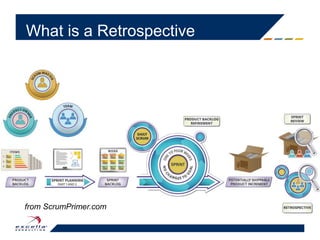Situational retrospectives
- 1. Situational Retrospectives One size does not fit all…..
- 2. • Agile trainer and coach • Member of PMI, Scrum Alliance, Agile Alliance, Agile Leadership Network • CST, CSM, CSPO, CSP, PMI-ACP, PMP • Founder & executive committee member of Agile Discovery for Agencies, Programs, and Teams (ADAPT) • Expertise in Federal and commercial Agile transformations Richard Cheng richard.cheng@excella.com @RichardKCheng
- 3. What is a Retrospective from ScrumPrimer.com
- 4. Scenario A Your team is great. You've continually met all your sprint goals and your Product Owner is pleased with the results to date. Yeah! Scenario B Your team did not do so well. Zero story points completed last sprint. Team members are complaining and blaming each other for the failures. What would you do?
- 5. Retrospective Prime Directive Regardless of what we discover, we understand and truly believe that everyone did the best job they could, given what they knew at the time, their skills and abilities, the resources available, and the situation at hand. -- Norm Kerth
- 7. +/Δ • Pluses – What went well • Deltas – What we want to do different
- 8. Silent Writing Team members silently write down their thoughts and then post or share the thoughts Dot Voting Each team member gets X number of votes to distribute across a selection of items Silent Writing and Dot Voting
- 9. Starfish
- 11. Team Radar Delivering Business Value Asking & Receiving Feedback Responding to Change Understanding Vision & Goal Planning Applying Technical Practices Working as a Team Continuously Improving Sprint 1 Team Self Assessment
- 12. Team Radar Delivering Business Value Asking & Receiving Feedback Responding to Change Understanding Vision & Goal Planning Applying Technical Practices Working as a Team Continuously Improving Sprint 5 Team Self Assessment
- 13. 5 Whys Why? Because the battery is dead Why? The alternator is not functioning Why? The alternator belt is broken Why? Belt was well beyond its useful service life Why? Belt was never replaced Why? Not following the service schedule My Car Won’t Start
- 14. 1. Ask the attendees to silently reflect on the on the events of the last iteration or release 2. Ask them to draw a picture reflecting their feelings 3. Place the picture on the wall 4. In turn, let each participant describe their picture and provide a title 5. Try to observe patterns to highlight significant events or impediment Draw Me a Picture 14
- 15. Future-spective • Imagine a date in the future • Run a retrospective to identify – Where we are? – How did we get here?
- 16. In your groups, pick a set of the retrospective techniques and identify situations in which they would be particularly applicable. Group Exercise 16 Techniques: – Pluses and Deltas – Silent Writing – Dot Voting – Star Fish – Niko Niko – Team Radar – 5 Whys – Draw Me a Picture – Future-spective
- 17. Retrospective Structure* 1. Set the Stage 2. Gather Data 3. Generate Insights 4. Decide What to Do 5. Close * from Agile Retrospectives – Making Good Teams Great
- 18. 1. Who should be in the retrospective? 2. Who should NOT be in the retrospective? 3. How long should a retrospective last? 4. Can the retrospective happen before Sprint Review? 5. Who facilitates the retrospective? 6. Who’s fault is it if the team keeps encountering the same problem over and over again? Other Notes on Retrospectives 18
- 19. 1. Think about the biggest problem plaguing your team or project 2. How long has it been an issue 3. Is there an effective way to form a retrospective to deal with this problem In Conclusion 19
- 20. Excella Consulting Experience and Expertise in Agile Solutions – Coaching – Training – Assessments – Agile Adoption – Agile Development Teams – Agile PMO Training Courses – Certified ScrumMaster (CSM) – Certified Scrum Product Owner (CSPO): Agile Business Analysis – Advanced Certified Scrum Product Owner (CSPO) – Certified Scrum Developer (CSD) – Agile Testing – Agile Business Intelligence and Data Warehousing – Automated Acceptance Testing – For Analysts and Testers See http://www.excella.com/training for more information
- 21. Books
- 22. Contact Information Richard K Cheng richard.cheng@excella.com 703-967-8620 Twitter: @RichardKCheng
Editor's Notes
- Bad feeling How proud are you of your code – at check in Tautman
- Set the Stage- DeBono, Prime Directive, Focus on – Focus off Gather Data – Team Radar Generate Insights- 5 whys Decide What to Do – SMART goals Close – fist of five





















